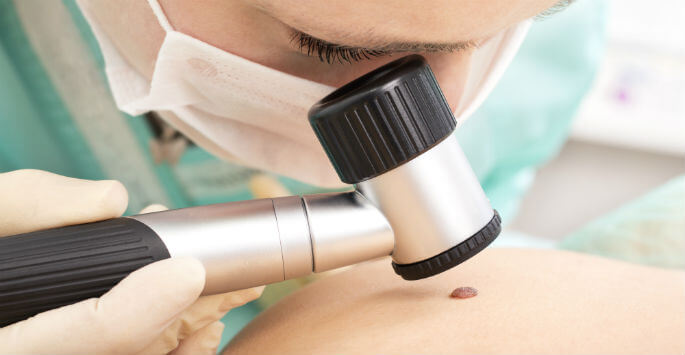During Mohs micrographic surgery, a local anesthetic is applied, and the surgeon begins to remove the skin cancer one layer at a time. As soon as they are removed, the layers are studied under a microscope. The skin layers are then frozen and stained with special dyes. Freezing the cells allows the surgeon to examine the entire tumor margin and create a map of the area.
Mohs surgery also enables the surgeon to study each layer for cancer cells closely, and it ensures that all of the infected cells are removed while leaving healthy tissue as unscathed as possible.
The operation is complete when no more cancer cells are detected in the layers. After completely removing the cancer, the surgeon then treats the wound. This procedure typically takes several hours, but the time needed is dependent on the size of the cancer. Depending on the extent of the surgery, the recovery can take from 2-4 weeks.
When is Mohs Surgery Performed?
Mohs is typically performed on cancers that are located in visible areas such as the nose, eyelids, or ears. Mohs is also performed on cancers that are likely to return. By removing the cancer in layers, the surgeon reduces the risk of leaving any cancer cells behind.
Mohs surgery is used if the cancer is a type that is likely to metastasize, like some squamous cell carcinomas or on fast-growing, aggressive cancers. The Mohs procedure can also be used in cases of pediatric cancer.
Benefits of Mohs Surgery
The benefits of Mohs surgery are preferred to those of traditional local incision, a procedure in which the surgeon removes the visible cancer and a small, surrounding area of healthy skin. Mohs surgery significantly increases the chances of all present cancer cells being removed, which reduces the need for additional surgeries or treatments. It also increases the odds of full remission.
An additional benefit to Mohs surgery is the entire cancer margin is examined. In conventional surgery, the surgeon examines only 1-3 percent of the margin, which greatly increases the risk of cancer cells being missed during the procedure. Mohs is also an outpatient procedure that can be done in our Windermere office.
The risks of Mohs micrographic surgery include bleeding, infection of the wound, scarring, and discomfort or pain.
At Dermatology and Skin Cancer Center, we are committed to diagnosing and treating problems of the hair, skin, and nails – including skin cancer. Living in Florida, our medical team understands the dangers of skin cancer and the importance of prevention and early diagnosis.
If you’ve been diagnosed with skin cancer or if you have any abnormal skin concerns (changing moles, spots, or freckles), contact Dermatology and Skin Cancer Center today. We’ll work with you to determine the safest and most effective treatment for your needs.

